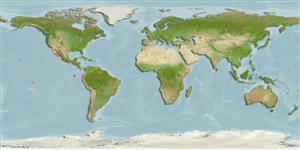Actinopterygii (ray-finned fishes) >
Perciformes (Perch-likes) >
Dactyloscopidae (Sand stargazers)
Etymology: Dactyloscopus: Greek, daktylos = finger + Greek, skopein = to look (Ref. 45335). More on author: Gill.
Environment / Climate / Range
Ecology
Marine; demersal; depth range 0 - 45 m (Ref. 11482). Tropical, preferred ?
Eastern Pacific Ocean: from the Gulf of California and southwestern tip of Baja California northward to Bahia Santa Maria. Former subspecies D. pectoralis fallax (Mexico to Ecuador, including Cocos Island) and D. pectoralis insulatus (Revillagigedo Islands) in Ref. 11482 were elevated to species level.
Size / Weight / Age
Maturity: Lm ? range ? - ? cm
Max length : 5.2 cm TL male/unsexed; (Ref. 11482)
Distinguished from D. fallax and D. insulatus by having the following characters: scales absent above the lateral line; upper lip fimbriae, modally 9; preopercular canal pores, modally 5; unbranched labial fimbriae (Ref. 82814).
Found on sandy bottoms near reefs (Ref. 37955). Feeds on small fishes and invertebrates (Ref. 11482). Minimum depth from Ref. 58018.
Life cycle and mating behavior
Maturity | Reproduction | Spawning | Eggs | Fecundity | Larvae
Allen, G.R. and D.R. Robertson, 1994. Fishes of the tropical eastern Pacific. University of Hawaii Press, Honolulu. 332 p. (Ref. 11482)
IUCN Red List Status (Ref. 115185)
CITES (Ref. 94142)
Not Evaluated
Threat to humans
Harmless
Human uses
More information
Common namesSynonymsMetabolismPredatorsEcotoxicologyReproductionMaturitySpawningFecundityEggsEgg development
Age/SizeGrowthLength-weightLength-lengthLength-frequenciesMorphometricsMorphologyLarvaeLarval dynamicsRecruitmentAbundance
ReferencesAquacultureAquaculture profileStrainsGeneticsAllele frequenciesHeritabilityDiseasesProcessingMass conversion
Tools
Special reports
Download XML
Internet sources
Estimates of some properties based on models
Phylogenetic diversity index (Ref.
82805): PD
50 = 0.5000 [Uniqueness, from 0.5 = low to 2.0 = high].
Bayesian length-weight: a=0.00389 (0.00180 - 0.00842), b=3.12 (2.94 - 3.30), in cm Total Length, based on all LWR estimates for this body shape (Ref.
93245).
Trophic Level (Ref.
69278): 4.0 ±0.61 se; Based on food items.
Resilience (Ref.
69278): High, minimum population doubling time less than 15 months ().
Vulnerability (Ref.
59153): Low vulnerability (10 of 100) .
